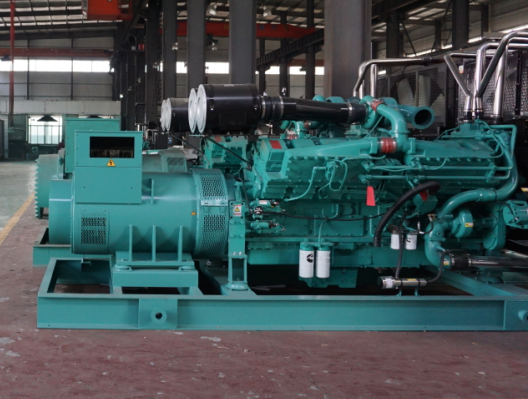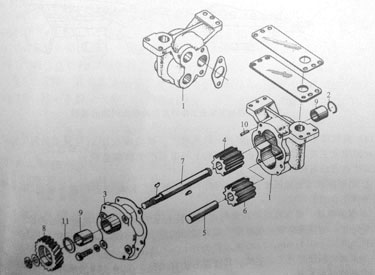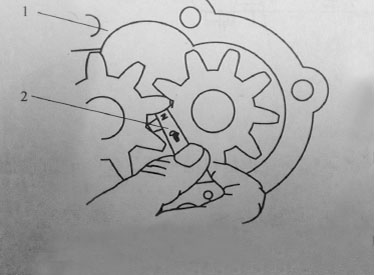The oil level increase and the oil pump noise are common faults in the diesel generator set lubrication system.
1. The fuel leaks into the oil basin, the plunger of the diesel engine fuel injection pump wears too much, the injector needle is not closed tightly or the needle valve is stuck in the open position; the clearance between the piston, the piston ring and the cylinder is too large, so that Fuel leaks under the cylinder wall to the oil sump.

2. The water seeps into the oil basin, and the cylinder head gasket is damaged; the cylinder wall communicating with the water jacket is cracked; the rubber sealing ring between the wet cylinder liner and the cylinder block is not installed correctly or damaged.
First, take out the oil gauge to check if the oil is too thin. If you find that the oil level is high and very thin, you should further find the reason to see if there is water or fuel leaking and dilute the oil. The inspection method is as follows:
Draw out the oil gauge and drop a few drops of oil on the paper to observe the oil color and smell. If the oil is milky yellow and has no other odor, it means that the water has entered the crankcase. Check whether the cylinder head gasket is damaged, whether there is crack in the cylinder water channel, whether the rubber sealing ring between the wet cylinder liner and the cylinder block is installed correctly or damaged. .
If there is fuel smell in the oil, start the engine to see if it is working well. If the exhaust pipe emits black smoke after starting the diesel engine, check whether the needle valve of the injector is properly closed. If there is dripping, it should be repaired. If the engine is underpowered at normal operating temperature, check whether the plunger of the fuel injection pump leaks diesel, and whether the clearance between the piston, piston ring and cylinder is too large, and replace or repair.
After checking the repair, release the old oil, clean the lubrication system, and re-add the specified amount of new oil.
Phenomenon: When the diesel engine is running, there is noise coming out at the oil magnetic device.
Cause: The oil pump drive gear and the driven gear are excessively worn or improperly gapped.
Inspection and elimination: If there is noise in the oil pump, check it after the diesel engine reaches normal temperature. Touch the screwdriver head near the oil pump, stick the wooden handle to the ear, and repeatedly change the speed of the diesel engine. If you hear a special noise and vibrate very much, it means that the oil pump is noisy. If the sound is not loud and even, it is normal. After long-term use of the oil pump, the gear wear is too large, not only has noise, but also can be observed from the reading of the oil meter. At this time, the reading of the oil pressure gauge is generally low.
Whether the lubrication system in the diesel generator set can ensure good lubrication conditions when the internal combustion engine is working. Although it is related to factors such as whether the oil passage is unblocked and the filter is functioning, the most important and decisive factor is the performance of the oil pump. Is it good? Therefore, during the maintenance of diesel engines. It is reminded that you should repair and repair the oil pump.

Fig 1. oil pump structure diagram
(1) The pressure limiting valve spring is broken and the ball valve is worn.
(2) Wear of the main and passive gear tooth surfaces, gear shafts, and pump body and pump cover.
(3) The tooth surface is peeled off, and the teeth are cracked and broken.
The increase in gear meshing clearance is caused by the friction between the gears of the oil pump gears.
The inspection method is as follows: the pump cover is removed, and the gap between the two teeth is measured by the thickness gauge at three points of the main and passive gear meshing at 120°.

Fig 2. 1-Oil pump casing 2-thick gauge
The normal value of the meshing clearance between the driving gear and the driven gear of the oil pump is generally 0.15-0.35mm. Each model has clear regulations. For example, the 4135 diesel engine is 0.03-0.082, the maximum is not more than 0.15mm; the 2105 diesel engine is 0.10-0.20mm. The maximum is no more than 0.30mm. If the gear meshing clearance exceeds the maximum allowable limit, the new gear should be replaced in pairs.
The gap between the main and passive gear end faces of the oil pump and the pump cover is the end face clearance. The increase in the end face clearance is mainly due to the friction of the gear in the axial direction with the pump cover.
The working surface of the oil pump pump cover will be sunken after being worn. The recess cannot exceed 0.05mm. The inspection method is as follows: the thickness gauge is matched with the steel ruler. The steel ruler is placed on the working surface of the pump cover, and then the gap between the working surface of the pump cover and the steel ruler is measured by a thickness gauge. If the specified value is exceeded, place the oil pump pump cover on a glass plate or flat plate and sand it with a valve.
There are two ways to check it.
(1) Fuse method
Place the fuse on the gear surface, install the pump cover, tighten the pump cover screw and then loosen it. Take out the flattened fuse and measure the thickness. This thickness value is the end face clearance. This gap is generally 0.10-0.15mm, such as 0.05-10.11mm for 4135 diesel engine and 0.05-0.15mm for 2105 diesel engine.
(2) Measuring with a thick gauge and a steel ruler
Gear end face clearance = pump cover recession + gap between gear end face and pump body joint surface.
If the end face clearance exceeds the specified value, there are two repair methods.
(1) Grinding the pump body joint surface and the pump cover plane.
(2) Adjust with a thinner gasket.
The gap between the top end of the oil pump gear and the inner wall of the pump casing is called the tip clearance. There are two reasons for the increase in the tip clearance.
(1) The gap between the center hole of the driven gear and the shaft pin is too large, causing friction between the top end of the gear and the inner wall of the pump cover, resulting in excessive tooth gap.
(2) The clearance between the oil pump shaft and the bushing is too large.
The inspection method is as follows: a thick gauge is inserted between the top surface of the gear and the inner wall of the pump casing for measurement. The tip clearance is generally 0.05-0.15mm, and the maximum is not more than 0.50mm, such as the 4135 diesel engine is 0.15-0.27mm, and the 2105 diesel engine is 0.03-0.15mm. If the specified allowable value is exceeded, the gear or pump body should be replaced.
The test method is: fix the pump casing and measure with the contact of the dial gauge near the drive shaft. Generally, the normal clearance is 0.03—0.15mm. For example, the 4135 diesel engine is 0.039—0.078mm, and the maximum is not more than 0.15mm. If the allowable value is exceeded, repairs should be made and there are two repair methods.
(1) The clearance between the bushing and the shaft is too large, the bushing is replaced, and the hole is reamed according to the size of the shaft.
(2) When the shaft is worn out and its out-of-roundness and taper degree are greater than 0.02 mm, it should be plated and thickened, and then ground to the standard size to reconfigure the bushing.
Common faults are ball valve and seat wear, spring break or loss of elasticity.
After the ball valve and the seat are worn, it is usually replaced with a new ball valve. After the new ball valve is installed, the copper ball is lightly tapped several times to make it fit tightly with the seat. If the spring breaks or loses its elasticity, it should be replaced with a new one.
Copyright © Guangxi Dingbo Generator Set Manufacturing Co., Ltd. All Rights Reserved | Sitemap
Update cookies preferences